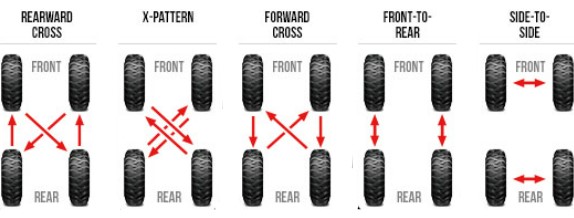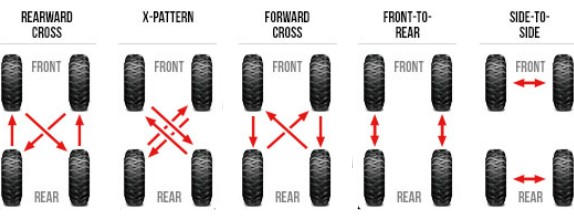Introduction
Explanation of Tire Rotation
 As a vehicle owner, it’s important to stay on top of regular maintenance tasks to keep your car running smoothly and safely. One of these tasks is tire rotation. Rotating your tires is the process of moving them from one position on your vehicle to another, and it’s an essential part of maintaining the longevity and performance of your tires. In this blog post, we will discuss the importance of proper tire rotation patterns and the benefits of regularly rotating your tires.
As a vehicle owner, it’s important to stay on top of regular maintenance tasks to keep your car running smoothly and safely. One of these tasks is tire rotation. Rotating your tires is the process of moving them from one position on your vehicle to another, and it’s an essential part of maintaining the longevity and performance of your tires. In this blog post, we will discuss the importance of proper tire rotation patterns and the benefits of regularly rotating your tires.
What is a Tire Rotation Pattern
A tire rotation pattern refers to the specific order in which a vehicle’s tires are moved from their original position. This process is performed to ensure that all four tires wear evenly and last as long as possible. Regular tire rotations can also improve vehicle handling and fuel efficiency.
Different Tire Rotation Patterns
When it comes to tire rotation, there are two main patterns that are commonly used: the “front-to-back” pattern and the “cross” pattern. The front-to-back pattern involves moving the front tires to the rear and the rear tires to the front. This pattern is typically recommended for vehicles with front-wheel drive. The cross pattern, on the other hand, involves moving the front left tire to the back right position, the front right tire to the back left position, the back left tire to the front right position and the back right tire to the front left position. This pattern is typically recommended for vehicles with all-wheel drive or rear-wheel drive.
Types of Tire Rotation Patterns Pros and Cons
Forward Cross Rotation
Definition: Tires are moved from the front to the back of the vehicle in a cross pattern, with the front left tire moving to the back right position, and so on.
Pros: Promotes even wear and prolongs the lifespan of all four tires.
Cons: Not recommended for vehicles with different size tires or different tread depths.
X-Pattern Rotation
Definition: Tires are moved diagonally across the vehicle, with the front left tire moving to the back right position, and the front right tire moving to the back left position.
Pros: Ideal for vehicles with different size tires or different tread depths.
Cons: Not as effective at promoting even wear across all four tires.
Rearward Cross Rotation
Definition: Tires are moved from the back to the front of the vehicle in a cross pattern, with the back left tire moving to the front right position, and so on.
Pros: Ideal for vehicles with rear-wheel drive or four-wheel drive.
Cons: Not recommended for vehicles with different size tires or different tread depths.
Side-to-Side Rotation
Definition: Tires are moved from side to side on the same end of the vehicle, with the front left tire moving to the front right position, and so on.
Pros: Ideal for vehicles with non-directional tires.
Cons: Not as effective at promoting even wear across all four tires.
Key takeaways
Different rotation patterns serve different purposes, depending on the vehicle’s tire size and drivetrain.
Always consult the vehicle manual or a professional to determine the best rotation pattern for your vehicle.
Importance of Follow the Manufacturer's Recommended Pattern
It’s important to note that the tire rotation pattern recommended by the vehicle’s manufacturer should always be followed. This information can be found in the vehicle owner’s manual or by consulting with a professional mechanic
Benefits of Proper Tire Rotation
 Proper tire rotation is important for several reasons. First and foremost, it ensures that all four tires wear evenly, which extends the life of the tires. Uneven tire wear can lead to a number of issues such as poor handling, reduced fuel efficiency, and an increased risk of blowouts or other tire failure. Additionally, rotating your tires regularly helps maintain optimal tire traction, which is essential for safe driving.
Proper tire rotation is important for several reasons. First and foremost, it ensures that all four tires wear evenly, which extends the life of the tires. Uneven tire wear can lead to a number of issues such as poor handling, reduced fuel efficiency, and an increased risk of blowouts or other tire failure. Additionally, rotating your tires regularly helps maintain optimal tire traction, which is essential for safe driving.
Proper tire rotation also helps to maintain the balance of your vehicle and prevent vibration, which can improve the overall driving experience. It also helps to reduce the risk of hydroplaning, especially in wet conditions. Overall, regular tire rotation is a simple yet important task that helps to keep your vehicle safe and improve its performance
How Often to Rotate Tires
The recommended interval for tire rotation varies depending on the vehicle’s manufacturer, but in general it’s recommended that tires be rotated every 6,000 to 8,000 miles or every six months, whichever comes first. However, it’s also important to pay attention to your tires and rotate them sooner if you notice uneven wear or other issues.
To keep track of your tire rotation schedule, you can use the odometer on your vehicle, or set reminders on your calendar. Additionally, you can also consult the owner’s manual or ask a professional mechanic for guidance on the best rotation schedule for your vehicle.
Regularly inspecting your tires for any signs of wear or damage, and having them rotated when needed, is a simple and effective way to extend the life of your tires, improve your vehicle’s performance, and ensure a safe ride.
Conclusion
In conclusion, tire rotation is a simple yet important task that should be performed regularly to maintain the longevity and performance of your tires. By following the recommended tire rotation pattern for your vehicle and rotating your tires every 6,000 to 8,000 miles or six months, you can help ensure a safe and smooth ride. Proper tire rotation as well as pressure ensures even wear, improves handling and fuel efficiency, increases tire life and maintains optimal tire traction. If you notice any signs of uneven wear or other issues, don’t hesitate to have your tires rotated sooner. Remember, regular tire rotation is an important part of regular vehicle maintenance that should not be ignored

